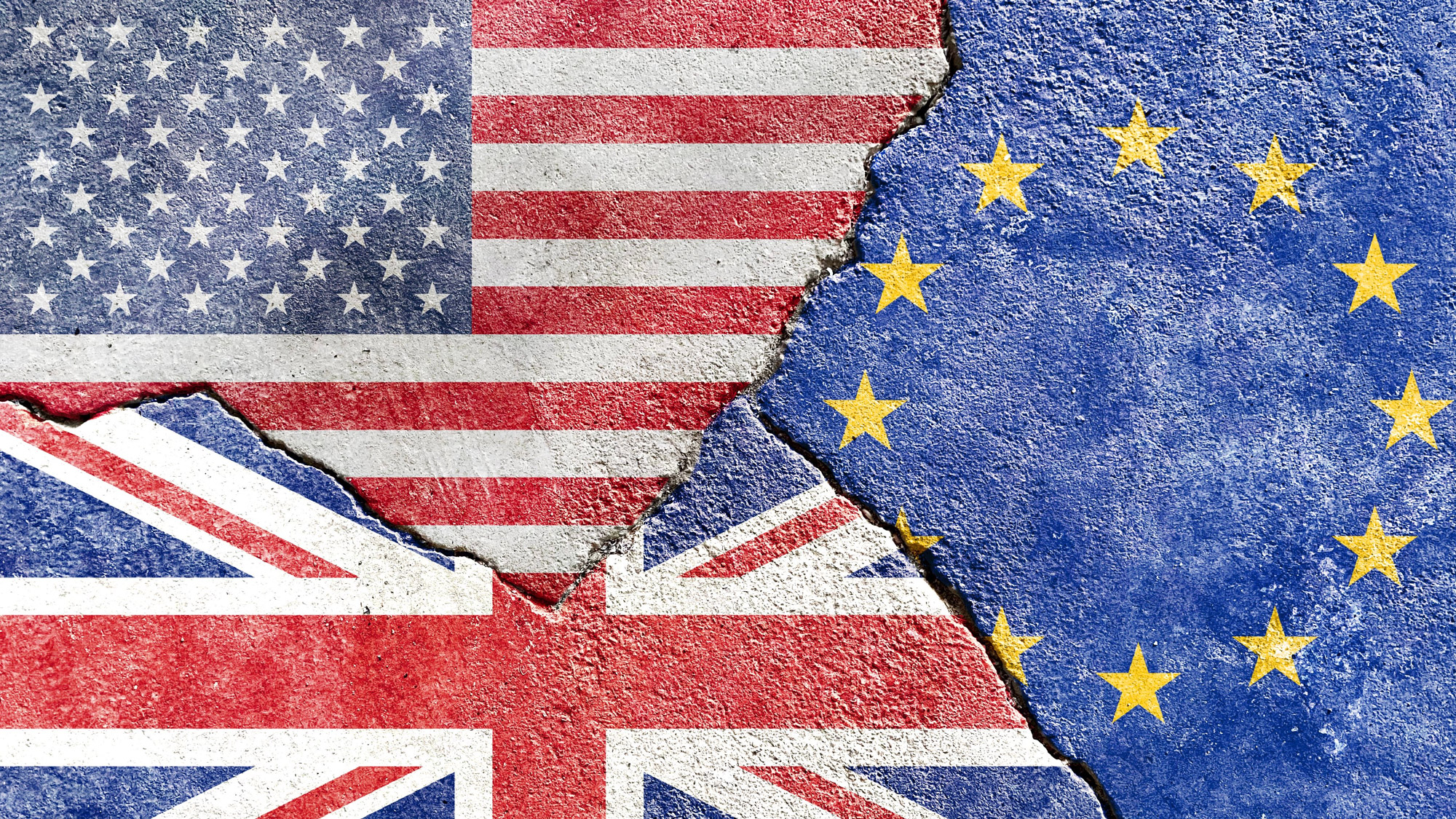Feature
Friends like these: US vs Europe
Anti-Europe messaging from the White House is coming at a time when Europe is seeking to rearm. Jen Kirby reports.

Ties between Europe and the US are strained. Credit: helloRuby / Shutterstock
In March 2025, the outgoing Portuguese Defence Minister questioned his country’s potential purchase of F-35s amid concerns around the United States’s reliability as an ally. Other partners echoed worries that US President Donald Trump could block components or software updates for the US fighter jet, manufactured by Lockheed Martin. The chairman of Denmark’s parliamentary defence committee said he regretted his role in procuring F-35s for the country.
“Buying American weapons is a security risk that we cannot run,” he wrote on social media. “We will make enormous investments in air defence, fighter jets, artillery, and other weapons in the coming years, and we must avoid American weapons if at all possible.”
Whether – and how much and how quickly – Europe can avoid American weapon systems is a question that America’s defence industries are also facing.
Europe is finally spending big on security, something that President Trump had pushed North American Treaty Organization (Nato) allies to do. But Europe wants to spend this money at home, mobilising as much as €800bn ($873.7bn) to incentivise investment in Europe or among partners that are not the US. Europe wants to make its defence and technological industrial base more resilient and less dependent on a US that is not just pivoting away from Europe, but is becoming adversarial, from temporarily halt on military and intelligence aid to Ukraine, to its tariff regime, to its threats to acquire the Danish autonomous territory of Greenland.
More than F-35 fighters may be at stake with Trump’s upheaval of the transatlantic alliance. Two-thirds of weapons imports by European Nato allies came from the US in the past five years. The US is the world’s largest arms exporter, and Europe is now its biggest buyer. From 2020 to 2024, 35% of US arms exports went to Europe, according to data from the Stockholm International Peace Research Institute (SIPRI).
“US companies are absolutely having to look right now at what the impact of the economics would be if some of those markets were to dry up,” said Eric Brown, a defence industry executive. “It's not an inconsiderable volume that's going into a number of nations, and if political tensions, or policy considerations, or just a rebalancing of the defence industrial base across regions ends up drawing down, that’s absolutely going to have an impact on future US orders projections.”
Trump’s unpredictable economic and security policies are adding to the uncertainty for US defence firms. Trump’s tariffs threaten to disrupt Pentagon supply chains, making weapons harder and costlier to produce. Other countries may retaliate with their own levies on components or arms.
Trump’s hostility toward Europe is undermining American arms makers' top selling point: the security guarantees that come attached to systems. At the same time, officials like Secretary of State Marco Rubio are warning Europe against excluding US companies from Europe’s defence investments.
“If I'm a US company, I certainly am worried about how accessible the European market will be long-term,” said Doug Berenson, partner in aerospace, defence & government at Oliver Wyman. “It is clear that they are building up their own productive capacity, that they're going to ramp up their own R&D in closely relevant capabilities.”
Breaking up is going to be very, very hard to do
Europe’s pivot away from US arms is still more potential than reality. Europe needs time to ramp up its defence industrial base and to scale up production to meet the demands of European militaries, who must enlarge their national fighting capacities if they seek to compensate for the US.
“It's going to be really hard for European Nato states, to just say, ‘you know what, from tomorrow onwards, we are not going to buy American arms,” said Mathew George, director of the Arms Transfer Program at the Stockholm International Peace Institute (SIPRI).
I think the US can still step in, in a big way, to fill some of those gaps
Diane Zorri, academic director of Strategic Studies at Norwich University
“That kind of decoupling is a lot more complicated than people would want to implement, and it's also a really expensive affair because it's not about just stopping the acquisition of new weapons. It's also about what you do with all of the training, the infrastructure, the planning for all of these contracts that are meant to last.”
Any breakup will also be painful for the US firms, which rely on partners to co-invest in research and systems development. The development and construction of F-35s is a project among allies, with components manufactured outside the US, including in Denmark and the United Kingdom.
“I think Lockheed Martin – as would the different subcontractors – would be very upset if there was any instability in the projected purchases of the F-35 from other countries,” said Bert Chapman, a professor at Purdue University and author of Global Defense Procurement and the F-35 Joint Strike Fighter.

Europe is lining up significant investment in defence. Credit: Anelo / Shutterstock
Nato interoperability – having all national systems to work together – is the standard for the alliance. Both Europe and the US, especially in recent years, sought to strengthen transatlantic defence industrial collaboration through efforts like ‘ally-shoring’ and joint ventures, especially in the wake of Russia's full-scale invasion of Ukraine. In December 2024, German officials broke ground on a factory in southern Germany that will be the first outside the United States to build Patriot missiles, a partnership between US defence firm Raytheon and German missile company MBDA.
Diane Zorri, academic director of Strategic Studies at Norwich University, said politics will guide things like joint ventures – but so will pragmatism. Europe may want to hedge against the US, but interoperability remains the order of the day.
“I think the US can still step in, in a big way, to fill some of those gaps,” Zorri said. “I don't foresee everything just pivoting to Europe. I think that's very drastic. I think they'll spend more. I actually think maybe the US will even come out a winner here.”
“I would have a guy in Germany right now,” Zorri joked, referring to the country’s fiscal rule changes, allowing it to invest billions in its military. “I would be like: ‘how can I get a piece of that 500 billion’?”
Winners and losers from Europe’s defence pivot
Defence analysts, industry insiders, and US officials all indicated that they see Europe’s defence investment as an irreversible shift, one that will have implications for both the European and US defence. The tangible outcomes are difficult to assess amid the Trump administration’s ongoing policy incoherence.
But Europe looks like a safer bet for defence investments. Michelle DiGruttolo, global geopolitical risk and intelligence at Sage Ravens Advisors, said, since March, she has seen a pivot, with investors looking into opportunities in the European defence markets – not just the big players, Germany’s Rheinmetall, but smaller contractors in new markets like Poland.

The political sway of the US is losing its lustre. Credit: Wirestock Creators / Shutterstock
That does have US defence firms worried about losing market share. Zorri said the market was big enough to handle a resurgent Europe. “It actually will make Americans push to become more competitive in that space, because I'm sure the Europeans will bring some great competitive advantages,” she said.
If the US is not going to be the US, why would anybody else ever buy any US military material?
Michelle DiGruttolo, global geopolitical risk and intelligence, Sage Ravens Advisors
But that hinges on whether the US still sees Nato and other alliances as in its security interests. “If the US is not going to be the US, why would anybody else ever buy any US military material? Why would they buy our planes? Why would they buy any programme that would rely on the US for maintenance or training packages?” DiGruttolo said.
The most critical question for defence firms is one only the US administration can answer: whether the package deal of weapons systems and Washington’s ironclad security backup still holds.
“I'm pretty sure that defence contractors are lined up at the door, with silver plate in hand, to the walls of Washington,” DiGruttolo said.
Caption. Credit:

Phillip Day. Credit: Scotgold Resources
Total annual production
Australia could be one of the main beneficiaries of this dramatic increase in demand, where private companies and local governments alike are eager to expand the country’s nascent rare earths production. In 2021, Australia produced the fourth-most rare earths in the world. It’s total annual production of 19,958 tonnes remains significantly less than the mammoth 152,407 tonnes produced by China, but a dramatic improvement over the 1,995 tonnes produced domestically in 2011.
The dominance of China in the rare earths space has also encouraged other countries, notably the US, to look further afield for rare earth deposits to diversify their supply of the increasingly vital minerals. With the US eager to ringfence rare earth production within its allies as part of the Inflation Reduction Act, including potentially allowing the Department of Defense to invest in Australian rare earths, there could be an unexpected windfall for Australian rare earths producers.
